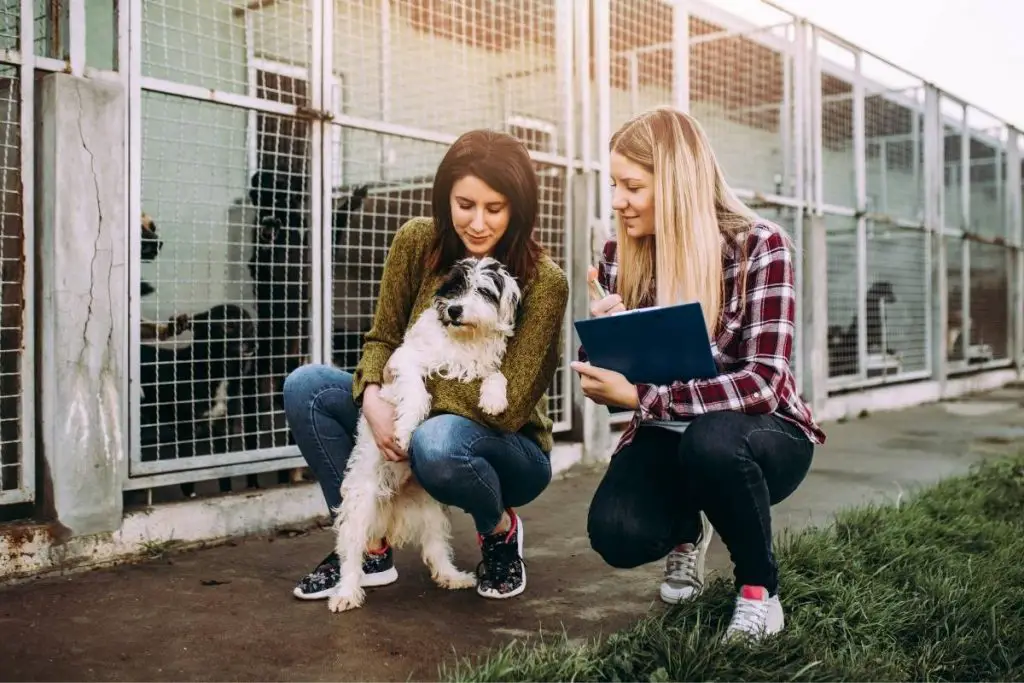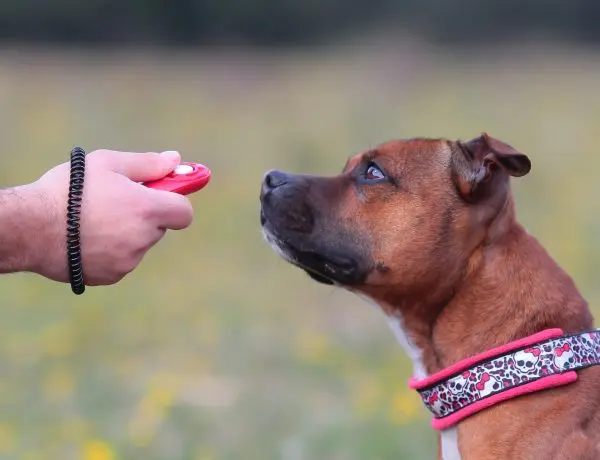With numerous advertising campaigns pushing the “Adopt, don’t shop” slogan and similar ideas, it seems that adopting a “rescue” dog is by far the best way to bring a dog into your family – but is it? Do rescue dogs really make the best pets?
The term “rescue” dog is often overused, and therefore it is impossible to say that every rescue dog makes a good pet. The answer to that question depends greatly on the dog’s history as well as the dog itself and what you are looking for in a pet.
Adopting a dog from a shelter that needs a home is a great thing. However, if the proper amount of research is not done, the dog may likely end up back in the shelter. In this article, we will go through the pros and cons of rescue dogs, as well as how to choose the best dog to fit your lifestyle.
Table of Contents
What is a “Rescue Dog”?
The term “rescue” is often overused. Dictionary.com defines a rescue dog as “a dog that has been placed in a new home after being abused, neglected, or abandoned by its previous owner.”
However, I have heard people say they “rescued” a dog – then tell me that they paid a large amount of money for the dog from an irresponsible breeder simply because they felt bad about the conditions the puppy was kept in. In my opinion, while that is good for the puppy, it should not be classified as a “rescue dog” if money was paid to continue to support that breeder in their unethical practices.
Dog Rescue Organizations and Shelters
With the animal rights groups constantly bashing dog breeders (no matter whether they are ethical or unethical breeders), people that choose to purchase a purebred puppy are often chastised by their peers for not “rescuing a dog.” That has brought about numerous rescue organizations popping up all over the country. Unfortunately, many of these groups are nothing more than dog trafficking groups that collect unwanted dogs from various sources and then adopt them to the well-meaning public as “rescue dogs,” often for fees as high as $600!

I recommend that you research the rescue group you plan to adopt a dog from as thoroughly as you would a breeder you would purchase a dog from. County-run shelters are generally reputable and ran in the best interest of the dogs. However, anyone can claim to run a rescue and adopt dogs out to the unsuspecting public.
I was made aware of a “rescue group” that adopted mixed breed puppies for $600, and they always had a supply of puppies to “adopt.” Supposedly, this group would take in pregnant females and whelp the puppies – however, I’ve been in the dog world for over 25 years, and the number of times I have heard of a pregnant female dog needing a new home is extremely low. That makes me wonder if they were perhaps just allowing their “rescue dogs” to create puppies for them to “adopt” at $600 each!
A client of mine adopted a dog (for a fee of about $300) from a local rescue group that turned out to be an aggressive dog. The rescue group only gave them minimal history about the dog. When they hired me to help them train the dog, I asked them to reach out to the rescue organization for more information on the dog, and the rescue’s phone number had been disconnected.
If you want additional information, the American Kennel Club has an excellent article available about what to look in a rescue organization.
How Do I Find the Right Dog for My Family?
After you have decided on a rescue group that you trust, it is time to begin your search for your family’s new addition. A reputable rescue group will usually require you to start that process with an adoption application. These can be lengthy! Be honest on your application and give the rescue group as much information about your family situation and what you are looking for in a dog as you possibly can. That will help them match you to the dogs best suited for your family.
Be wary of any rescue group that allows you just to stop by and choose the first dog you like. The rescue staff and foster homes should have spent time with the dogs and know something about their personalities and any quirks they might have. Like a responsible breeder, they should guide you to the dog or dogs they feel would be the best fit for your particular home.
An enormous benefit to adopting an adult dog from a rescue is that you not only know the size and coat-type of the dog, but you often can find out something about their temperament. For instance, is the dog good around children and other dogs?
Rescue organizations that utilize foster homes for their dogs are often able to give adopting families more information about the dogs than a rescue that uses a shelter-type situation. That can be a great benefit to families looking to adopt!
In shelters, some dogs do not show their true colors. They may “shut down” and seem much calmer and quieter than they would be in a home setting, whereas others do the opposite. They might show extreme excitement whenever a potential family comes to visit (jumping and barking). Yet, in a home environment with plenty of attention every day, they would be calm and pleasant to be around.
Another benefit to a rescue dog from a reputable organization is that you can often adopt the dog on a trial basis. If they offer this option, take advantage of it! That cute pup that fits in great with his active foster home (that has another dog, three kids, and a parent at home all day) might not fit in so well in a house with no other pets and an owner that works full time. A trial basis allows you to see if the dog is truly an excellent match for your home while allowing you to safely return it if it is not the right dog for you.
Contrary to what some people believe, most times, dogs do just fine with changing homes – even a few times – so long as all of the homes they are switched to are safe, and the dog is treated well in each. It is MUCH better to send a dog that does not fit into your home back to the rescue where they can eventually find THEIR perfect home. The alternative could result in many unhappy years for both you and the pet!
A couple of reputable rescue organizations to check out are:
How Much Does a Rescue Dog Cost?

That is a difficult question to answer, as there are many variables. That stray that wanders into your yard might appear to be free of charge, but there are likely to be additional costs that will quickly follow! Some of these costs could include:
- Vet visits
- Vaccinations
- Heartworm test/medication
- Spay or neuter
- Dog food
- Supplies: crate, dog bed, toys, leash & collar, etc.
- Obedience classes
Most reputable rescue groups charge an adoption fee for the dogs they place. This fee varies by organization and location. Many shelters and rescue groups will also vary their prices between individual dogs based on the dog’s age, size, and specific needs.
You can generally expect to pay higher adoption fees for younger dogs and puppies, with many rescues offering discounted or even free adoptions for senior pets. Prices for a puppy from a reputable rescue organization tend to run between $350-500. Adult dogs are often more in the range of $200-400.
Some county-run shelters (as well as other groups) often have reduced rate adoption promotions, and sometimes they even offer free adoptions. If you have done your research and are genuinely ready to add a dog to your life, this can be great! However, a dog should never be an impulse purchase! Those “free adoption days” are not beneficial to the dogs if they end up in homes that were not prepared to take proper care of them!
While these adoption fees may seem a bit high, they come with “extras”! Suppose you are adopting from a reputable rescue group. In that case, your new dog will already be spayed or neutered, up to date on their vaccinations, and have received a clean bill of health from a veterinarian (or you will be notified of any health issues they have). Some even come with free or discounted training classes! Of course, there are dogs available on Craigslist and other sites for much less money (even free sometimes). While one of those dogs might end up being a healthy, wonderful companion for you, more often than not, you will likely have to invest a lot more money into them down the road than you would by adopting from a shelter or rescue group.
Can a Rescue Dog be a Purebred?
Absolutely! While most of the dogs in shelters are mixed breed dogs (and a HUGE portion of them currently are pit bull mixes), purebreds do occasionally end up there. However, the number of purebred dogs in shelters is usually extremely low. In part, that is because responsible breeders will ALWAYS take their puppies back should the original home not work out.
Another reason for the small number of purebreds in shelters is that they are often pulled out of those shelters by a purebred rescue organization dedicated to the rescue of one specific breed. These purebred rescue organizations are very familiar with their particular breed. They are often able to screen homes more thoroughly than a shelter, which ensures a good match for the dog. You can find out about rescue options for just about every AKC breed by going to the parent club website for a breed you are interested in.
Pros to a Rescue Dog

- You are providing a home for a dog in need. Of course, this is the obvious benefit and an important one!
- You can choose the age. Adopting a rescue dog is excellent for those people that don’t have the time or desire to spend a year or two dedicated to raising a puppy.
- You often get great value for your money. When you adopt a dog from a reputable rescue group (and occasionally even from a private party), the dog will usually be up to date on its vaccinations, already spayed/neutered, and have had a thorough veterinary exam.
- You most likely will know the size, coat-type, and look of the dog. Of course, this is not true with puppies adopted through rescue (you have much more predictability with a purebred puppy from a reputable breeder), but choosing an adult dog is an easy way to know exactly what the dog will look like.
- You can “try before you buy.” Again, this is true with a reputable rescue organization and most shelters. You can often take the dog home for a couple of days to make sure they are a good fit for your family. If they are not, you can return the dog to the rescue group, and that dog can safely wait for another family that would be a better fit for them.
- There are MANY dogs to choose from. While research and planning should ALWAYS be done before bringing a dog into your family, you shouldn’t have to wait a long time to find a dog to rescue. Shelters usually have several dogs available at any time. However, this might not be true if you are looking for a particular breed or size of dog – in that case, the wait might be much longer.
Cons to a Rescue Dog

- The history and pedigree of your dog will likely be a mystery. That is not always the case, as some dogs are re-homed by the original owner or breeder. In this case, you may be given a complete and accurate history of the dog (and maybe even a legitimate pedigree if the dog is purebred). But, with a stray dog or one dropped off at the shelter, it can be a guessing game as to what sort of training and socialization the dog has had, as well as the genetics behind the dog.
- Some rescue dogs come with baggage. Many times, dogs end up in shelters due to behavior issues that their original owners were unwilling to deal with. With proper training, these problems can often be remedied. However, a dog that has suffered from a lack of socialization or has had bad habits encouraged can be a definite challenge to rehabilitate.
- You may be taking on a dog with expensive medical problems. Although most reputable rescue organizations will have the dog examined by a veterinarian and disclose any issues to you before adoption, you still take a risk with a dog from an unknown genetic background. There is a myth that mixed breed dogs are healthier than purebred dogs, but this is not always the case. There is very little scientific research to back this up, as many more studies are done on the health of purebred dogs, and therefore the numbers of health problems APPEAR to be higher. In reality, this is difficult, if not impossible, to prove – as mixed-breed dogs can often be prone to health issues present in each of the breeds that make up that mixed-breed dog. While doubling up on problem genes can undoubtedly increase your chance of health issues, reputable breeders do genetic testing and carefully plan out their breedings to significantly reduce these risks.
What Are Some Other Ways to Rescue a Dog?
If the thought of researching rescue organizations or wandering through hundreds of kennels at a shelter seems overwhelming, there are some other great ways to rescue a dog!
- Talk to the staff at your veterinarian’s office. Call or stop by and let them know that you are interested in adopting a dog. Having worked in vets’ offices, I know that clients often told us of situations where they needed to re-home their dogs. Sometimes this was due to an unplanned move or health issue with a family member. Yet other times, we had clients that couldn’t afford their dog’s medical bills and relinquished the dog to the vet to treat and then place up for adoption. Most of the time, in situations like this, medical history is known on the dog as well as some behavioral information.
- Talk to your co-workers, friends, and neighbors. Putting the word out among friends can sometimes result in finding a great dog that needs a new home. Again, for reasons like moving or health problems, sometimes people need to re-home their dogs, yet they are hesitant about taking them to a shelter. Networking with people you know can be a great way to offer a wonderful home to these dogs in need!
- Foster for a rescue organization. Many rescue groups are always in need of foster homes. Opening your home up temporarily to a dog in need can be a great way to fill that space in your family while you search for the perfect new family member. Hopefully, that dog you foster will find their ideal family soon…and, you never know, that ideal family might just be yours!
How Do I Help My Newly Adopted Dog Become a Great Pet?
So, now that you’ve adopted a dog, it is time for YOU to help them become a great pet! Hopefully, you have chosen a dog with the right energy level for your family and size that your home can accommodate. Whether that dog has had years of training by its previous owners or was just found wandering along the street, there will be an adjustment period while you get to know the dog, and it becomes comfortable in your home.
A few simple steps can help increase the odds of ending up with a valued family member for years to come.
- Introduce your dog to its new home slowly. Especially if your dog is coming from a shelter, you might be anxious to show them your spacious new house and yard that they can now call their own. As tempting as it is to turn them loose to explore on their own, do not do that! It can be overwhelming for a new dog and may result in indoor potty accidents or a dog that becomes fearful and difficult to catch as they realize they are in a new place with people they don’t know. You can set yourself up for success by immediately taking the dog to your yard ON LEASH when you return home. Give him a chance to relieve himself (in the area you would like him to use for this) and allow him to explore his new yard with you quietly trailing behind holding the end of the leash. After he has checked out the yard (make sure he has also gone potty!), take him inside (STILL ON THE LEASH) and allow him to check out the areas you will be eventually allowing him access to.
- Introduce your dog to a crate. If your adopted dog is already comfortable in a crate, this should be easy! Have a crate set up for him in a quiet area of the house, but where he can still see family activities. Let him go in and check it out! If a crate is new to him, you will need to take some additional steps to crate train him. For the first day, just toss a tasty treat into the crate and allow him to go in to retrieve the treat and come right back out. You can work on crate training over the next several days, but for now, let’s move on to step 3.
- Take your dog for a walk. Taking your new dog for a short walk around the neighborhood is a great way to bond with him! Besides bonding, it gives him a chance to learn a bit about the area and look to you for guidance as he navigates his new community.
- Supervise your dog carefully as you allow him access to your home. After your walk, if things have gone well so far, you can begin to allow your dog some access to your home. Close doors and use baby gates to encourage him to remain in the area where you can watch him. If this is not possible, it is best to keep him on the leash for at least the first several hours as he becomes accustomed to you and your home.
- Set your rules and teach them from day one. Your new dog is going to take some time to settle in and learn the rules. You can make this easier for him if you teach the rules from the beginning. For example, if you don’t want him on the sofa, don’t allow him up there from the start. It is unfair to allow him more freedom at the beginning and then change the rules on him later.
- Don’t overwhelm your dog. You are probably really excited to show off your new pet to family and friends. However, like everything else, you should take that slowly. Spend the first couple of days just getting to know each other before you overwhelm him with many visitors or outings. Once he trusts you and understands the rules you’ve set, he should be more comfortable being introduced to the people and situations that are going to be part of his regular life now.
Happily Ever After

Some of the best advice I can give you is to be like your dog and live in the moment – especially when it comes to living with a rescue dog. Regardless of what your dog went through before they met you, they are with you now – and hopefully, you are a GREAT home for them! Leave their past in the past and do not dwell on it.
Sign up for a local obedience class, even if your new dog knows basic commands. It will help increase the bond between you and your dog, and it will give you access to professional help should any issue arise that you are unsure how to deal with.
I often encounter clients that make excuses for their poorly behaved dogs because they feel sorry for the life the dog had before they adopted them. That does not do your dog any favors. While their past may explain why they do certain things, it does not need to be an excuse to continue that way. Think of your home as a fresh start for the dog. You may need to go slowly and build that trust, but dogs thrive on structure and consistency, so be sure to offer that to them!
Rescued dogs CAN make excellent pets, so long as you choose the right rescue dog for your family. If you put in the time, both before you choose your dog and after you bring it home, adopting a rescue dog can be an incredible experience. You will end up gaining a new best friend, and you can also take pleasure in knowing that you gave a great home to a dog in need!




